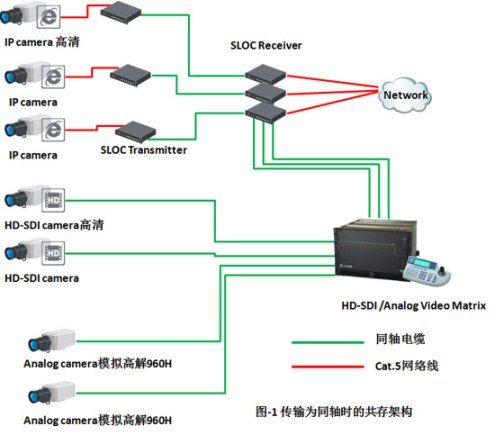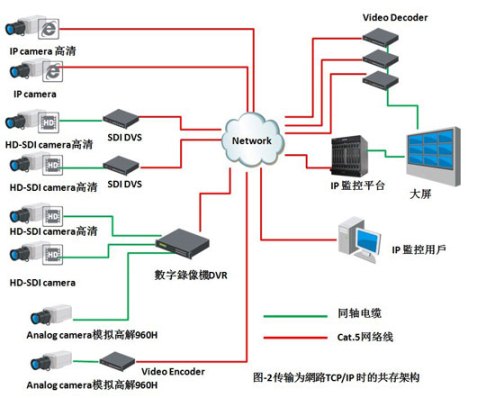In 2012, HD surveillance entered the full-year application of full HD and high resolution, including IP network HD and HD-SDI HD, and even the 960H analog high line entered HD application issues. However, in a high-definition trend, the author found many doubts about the application of HD-SDI HD and 960H high-resolution high-definition cameras between manufacturing and engineering companies, and found many solutions for IP HD. The trend of distrust and ignorance is obvious. This situation inevitably reminds us of the same situation in the market for IP system applications when the IP network camera was just started in 2008. How to resolve and resolve these doubts and concerns? HD is a trend that cannot be turned back. It is time to think about how to integrate the high-definition versions of IP and SDI in different ways. Let us explore how to apply the methods one by one. Solve these needs. This article refers to the address: http:// How IP, HD-SDI HD and analog high-line cameras coexist After the emergence of HD-SDI at the end of 2011, IP network cameras and HD-SDI cameras have a market application complex in the security industry, which is often used by the media and the advantages and disadvantages of the two sides in practical applications. Vendors zoom in to discuss, but in fact, from the perspective of engineering pragmatism, IP and HD-SDI and analog high-line are products that appear to improve the recognition rate and clarity of surveillance images. The purpose is the same and the application is consistent. It should be Hybrid coexistence is the king of HD surveillance applications. First of all, we look at the high-definition and high-resolution front-end; regardless of IP or SDI high-definition, its appeals are widely seen, and both are real-time and smooth. There is no need to discard any HD images that may be provided in the application. Opportunity, but how do you use these different HD cameras in front end coexistence? To coexist and use, we must first consider the architecture problem in the existing transmission. If the original system is a coaxial transmission system, then we can divide the two ways to solve the coexistence of these three cameras. The first one is under the architecture of the traditional coaxial cable (Figure-1). We can add the SLOC (SignalLink OverCoaxial) transmitting and receiving unit to the back end of the IP network camera, and use the principle of transmission and conversion to enable the IP HD camera. The existing coaxial cable of the original system can be used, and at the same time, the TCP/IP signal and the video video signal output can be simultaneously provided on the SLOC transmission device, and the TCP/IP network signal enters the SLOC transmission device and is then restored to the network signal to enter the network. The routing architecture, while the Video image and video signal can enter the existing analog image matrix or HD-SDI matrix system or digital recording organic DVR, this part first solves the obstacle problem of IP network camera transmission in the traditional coaxial cable. It also solves the problem that the main structure of the analog system cannot be replaced or the cable cannot be replaced. The SMPTE-292 broadcast signal from HD-SDI can be transmitted on the traditional coaxial cable. Therefore, after receiving the SDI signal, the signal can be directly input into the HD (SDI)-DVR or matrix system. To change the high-definition architecture for the system and let IP and SDI HD coexist. If you want to consider the existing analog camera or 960H high resolution camera to be included in the system, then the 960H analog high resolution in the same coaxial cable architecture is the general analog camera integrated into the same system through DVR or matrix. Coexistence is also difficult. In fact, such a structure is currently adopted by many engineering companies in multiple mixed cases. The second is when the transmission system architecture is TCP/IP network architecture (Figure 2). At this time, the IP network camera is the main architecture of the whole system, and the non-IP HD-SDI HD and 960H analog high resolution Is it necessary for a general analog camera to be incorporated into a system to have the same mechanism for transmission and conversion in order to allow the simulation to run smoothly with HD-SDI HD in a single monitoring system architecture? There are two different ways to turn HD-SDI signals into TCP/IP networks. We can take HD-SDI HD cameras from all systems onto HD (SDI)-DVR and then DVR. The output TCP/IP signal is encoded as a network device route, so that the video and video control and PTZ control of the HD-SDI camera can be performed through the CMS software or the browser of the DVR itself. Then we can also use the SDI-DVS image encoder to convert the HD-SDI camera signal directly into the TCP/IP signal by means of the encoder Encoder, so that the HD camera can be individually used like an IP camera. SDI images become a way for network signals to be IP-monitored directly on the route. As for the 960H analog camera, the same principle is adopted after the 960HDVR is acquired and then directly monitored by the IP route. In addition, the image video signal can be directly converted into the TCP/IP mode by the image encoder DVS to meet the requirements of the network monitoring architecture. . Having said that; there will be engineers who question the part of the transmission distance and the last image format. Moreover, there will be engineers or readers who will question the compatibility of the 960H and HD-SDI signals on some transmission and containment equipment. The problem, and even the screen display format problem, and the exchange of the back-end unit format and the compressed parsing comparison, etc., these problems are very good, very practical, we pick some in the next paragraph Discuss the more important issues. Transmission distance problem between IP, HD-SDI and analog high solution Speaking of the above readers and engineers may question the problem part. First, let's look at some distance and conversion problems that may not be actually overcome on the transmission. Generally, when comparing IP network HD and HD-SDI HD, the industry or engineering Businesses often use HD-SDI or analog distance to explain the advantages and disadvantages of IP and HD-SDI, but the author's view on engineering applications is really unnecessary to carry out these three types of transmission distances in HD monitoring requirements. The last glimpse of the image format as a barrier to system integration, and the current IP network HD and HD-SDI HD or even 960H high-resolution analog camera in a high-resolution common goal is not necessary in the selection due to transmission problems In fact, with the current large-scale monitoring project; due to the rapid development of optical fiber communication technology, the cost of optical fiber transmission monitoring system has been greatly reduced, so the application of optical fiber and optical transceivers in various high-definition surveillance systems is becoming more and more Popularization and current investigations have found that optical fibers have been widely used in various industrial monitoring systems. In addition, in the monitoring system HD-SDI signal transmission, the general short distance of 100-200 meters can be mostly used for coaxial cable transmission, or can be added to the repeater (Booster) way, the transmission distance is extended to 400-500 Around the meter. In the case of long-distance transmission in the network architecture, the most common is that HD-SDI is converted to fiber-optic cable transmission through the optical transceiver of Fiber, and in order to meet the one-way or two-way transmission of multiple HD-SDI signals, the optical transmission architecture also has Multi-channel optical wavelength division method transmission such as WDM/DWDM/CWDM achieves more than one HD-SDI or analog image fiber signal transmission transmission requirement, which can make analog and HD-SDI camera signal transmission reach 30-70 Kilometers. In principle, this kind of transmission application is quite similar to the distance of most industrial applications transmitted by the network. This architecture based on fiber-optic network, supplemented by the Internet and coaxial, has been greatly improved in the monitoring project. The adoption of this architecture maximizes cost savings and reduces the impact of bandwidth on IP or HD-SDI HD video transmission. IP and HD-SDI HD's more troublesome storage sharing The original analog system and most of the HD-SDI storage systems use the local DVR local storage method. For the moment, HD images can be used for HD-SDI signals or analog and network HD images. DVR, HD-NVR for access and storage. Taking HD-SDI as an example, this standard is mainly for resolution 720P or 1080P, frame rate is 25 or 30, and the amount of data after analog-to-digital conversion is 1.485 Gbps. The cost of directly storing this data amount is quite large. Therefore, from the practical considerations, the video storage still needs to return to the network compression processing, and it can also use the D1 image quality for general recording, and the event high-definition video recording and the like. This not only does not detract from the transcription of high-definition images, but also provides a real-time smooth video source. According to the conversion video of 720P or 1080P@30 frames, the storage capacity calculated by 400-650 megabytes per hour requires about 350-500G per channel per month, and so on can estimate the required digital hard disk recorder. The number and configuration of HD monitors is the best recording method using IP or HD-SDI HD. How IP and HD-SDI HD operate in the backend management In addition to the IP network monitoring and management platform, many vendors have launched a new all-digital, open network video networking platform for HD-SDI matrix or HD-DVR, which can call matrix encoding or HD-DVR encoding. The video can realize the mutual integration, alarm linkage, information integration and unified release and management of control information with the system between the IP integrated monitoring and management platform VMS or NVR. With powerful data management functions, it can centrally manage, retrieve, query, analyze and count system data, including various event information and alarm information. However, many people are still skeptical about the current management platform tools of HD-SDI cameras, but in fact, they will encounter problems in integration and centralized control. However, it is not difficult to realize this demand. The front-end part adopts the transmission mode of the coaxial cable and the optical transceiver to send all the roadside signals back to the control center, and the image is demodulated and then connected to the large-screen real-time monitoring, and the signal is also solved. After adjustment, enter the HD-SDI recorder with network connection function, and use the management platform software to manage all SDI matrix or HD-DVR network management, so that not only the IP platform management requirements can be achieved, but also the monitoring can be carried out conveniently and quickly. Point to different HD format screen transfer work; at the same time; another solution is to demodulate the image and encode it into the HD NVR/NAS/SAN for storage and management. The above is just a simple explanation of how to use transmission and conversion to integrate various high-definition high-line monitoring solutions to do a project application. However, I believe that under the practice of no practical training, there will still be some different HD and high solutions for the integration of engineering companies. Part of the question. This author can understand that after all, some HD-SDI high-definition and 960H high-solution knowledge popularization and application examples are few. It is still necessary to have advanced engineering and readers to fully accept it, but there is a point that must be explained here. High-definition is an inevitable trend of monitoring requirements, but different high-definition and high-resolution formats must have their development reasons and application base points. This is an indispensable view for engineers or integrators. 7.2 Volt Battery Pack,Best 18650 Battery Charger,18650 Battery Size Shenzhen Powercom Electronics Co., Ltd. , https://www.expowercome.com
